In 1905, a young Venetian artist, Gino Rossi (born Luigi Rossi, Venice, 1884 - Treviso, 1947), was granted a studio on the third floor of the seventeenth-century palace of Ca Pesaro on the Grand Canal: this was the beginning of the career of a great artist who, after sojourns abroad, made Venice, and in particular the island of Burano, his most cherished place. Seventy years after his death, precisely at Ca Pesaro, where it all began, the exhibition Gino Rossi in Venice. Dialogue between the collections of Fondazione Cariverona and Ca Pesaro retraces the decisive steps of this painter’s career. Curated by Luca Massimo Barbero and Elisabetta Barisoni, this retrospective focuses attention on the most rebellious artist of the Capesarino group through a selection of landscapes and portraits that will be on view until May 20.
After training in Venice, Gino Rossi moved to Paris in the early 20th century with lamico and colleague Arturo Martini (Treviso, 1889 - Milan, 1947). His stay in the French capital, a stimulating city and meeting point for many artists, proved to be of great importance; here, in fact, he came into contact with the works of the Cubists and the Fauves and was profoundly influenced by them. Meanwhile, in a traditionalist Italy still tied to academic painting, the city of Venice began to open up to the new and manifest change. In 1907, after winning a competition, Eugenio (Nino) Barbantini (Ferrara, 1884 - 1952) became director of the Gallery of Modern Art in Ca Pesaro and immediately set to work to organize not a permanent exhibition, but a series of exhibitions with works by original and creative artists. For the young generations from Veneto, Ca Pesaro was the first and for some time the only center around which to gather and confront themselves, and it was here, starting in 1908, that the young Gino Rossi exhibited his works, immediately showing his revolutionary character. Thanks to his abandonment of form and works of an almost archaic expressiveness the artist soon established himself as the most anti-academic among the rebels of Ca Pesaro according to the famous definition of the art critic Silvio Branzi.
In the exhibition there are many landscapes depicting the Venetian lagoon, works of great strength both for their intense colors and for their form, which is clearly anti-graceful. A place very dear to the artist was the island of Burano, far from the chaos of the city, a silent refuge where he retired to live and paint. In works such as Barene a Burano (1912-1913), Gino Rossi shows an unspoiled, non-idyllic nature that is clearly affected by his stay in Brittany. Another famous landscape is Marina Douarnenez (1910) for which Rossi draws on the painting of Gauguin and the Pont-Aven group. In the works of the 1910s, color takes on a profound significance for the artist; the canvases are dominated by blues and greens but also by warmer tones, colors that are always full-bodied and full-bodied and which, especially in the landscapes, help to leave a sense of precariousness and suspension.
In addition to landscapes, portraits are of great importance. He, as can be seen in the work Pescatore Buranese (1912-1913), chooses humble people living on the margins of society. Certainly unrefined works, sometimes unpleasant and crude, but truthful, and showing hard work, toil. Gino Rossi manages to masterfully render all this through thick outlines and coarse brushstrokes that highlight the expressions, wrinkles and hardened features of these characters. Also of great intensity is Ritratto di signora (Portrait of a Lady), a work from 1914 that shows a woman with a gaunt face, humble and simple in dress and pose, a work in which one can clearly see the suggestions that Expressionism exerted on the artist during his French sojourn.
 |
| Gino Rossi, Burano (1912-1914; oil on cardboard, 42 x 57.2 cm; Verona, Fondazione Cariverona Collection) |
 |
| Gino Rossi, Barene a Burano (1912-1913; oil on cardboard, 59.5 x 70.4 cm; Verona, Fondazione Cariverona Collection) |
 |
| Gino Rossi, Marina - Douarnenez (c. 1910; oil on canvas; Venice, Galleria Internazionale di Arte Moderna Ca’ Pesaro) |
 |
| Gino Rossi, Portrait of a Lady (1914; oil on cardboard applied to chipboard, 99.8 x 71.5 cm; Verona, Fondazione Cariverona Collection) |
 |
| Gino Rossi, Study for Still Life with Violin and Pipe (ca. 1922; chalk on paper; Venice International Gallery of Modern Art Ca’ Pesaro) |
The exhibition includes a number of works executed in the 1920s in which a change in the artist’s painting can be observed. In landscapes and in works such as Study for Still Life with Violin and Pipe (1922) the artist uses colored chalks and focuses on composition, on form. These are works that, precisely because of this great attention to structure and volume, can be linked to the art of Paul Cézanne, whom the artist had been able to admire two years earlier, in 1920, at the Biennale.
Unfortunately, Gino Rossi’s career came to an early halt. Deeply scarred by World War I, the artist was interned in the SantArtemio asylum in Treviso where he spent the last twenty years of his life until his death in 1947. Innovative and very personal, despite the not so many years of work, Gino Rossi still managed to leave a mark thanks to his expressive works in which he shows simple landscapes and humble characters, works that especially thanks to color are strong and evocative.
Warning: the translation into English of the original Italian article was created using automatic tools. We undertake to review all articles, but we do not guarantee the total absence of inaccuracies in the translation due to the program. You can find the original by clicking on the ITA button. If you find any mistake,please contact us.